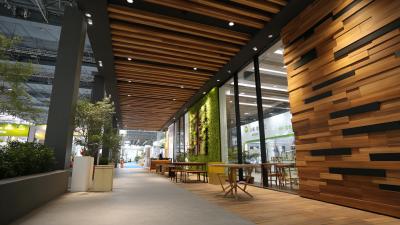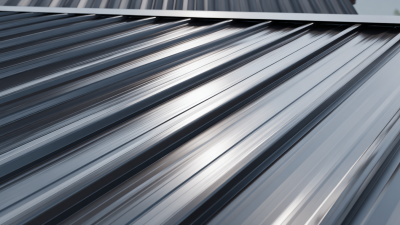Transform Your Home: The Ultimate Guide to Choosing the Right Exterior Cladding for Energy Efficiency
The choice of exterior cladding plays a pivotal role in enhancing the energy efficiency of a home. As homeowners increasingly seek to optimize their living spaces for both comfort and sustainability, understanding the impact of cladding materials on energy consumption has become paramount. According to the United States Department of Energy, nearly 50% of a home's energy is used for heating and cooling. Thus, selecting the right exterior cladding can significantly reduce energy costs and minimize a home’s carbon footprint.

Recent studies indicate that certain cladding materials, such as insulated vinyl and fiber cement, can offer superior thermal performance, potentially saving homeowners up to 20% in energy bills annually. In addition, the International Code Council has highlighted that energy-efficient exterior cladding not only contributes to better indoor climate control but also enhances the overall durability and longevity of building structures.
This comprehensive guide aims to equip homeowners with essential knowledge on various exterior cladding options, enabling them to make informed decisions that align with both their aesthetic preferences and energy efficiency goals.
Understanding Energy Efficiency in Exterior Cladding
When it comes to exterior cladding, understanding energy efficiency is paramount for homeowners looking to reduce their energy consumption and environmental footprint. According to the U.S. Department of Energy, proper insulation and efficient cladding can reduce heating and cooling costs by up to 30%. This remarkable statistic emphasizes the importance of selecting materials that not only enhance the aesthetic appeal of your home but also improve thermal performance.
One key consideration is the material’s R-value, which measures insulation effectiveness. For instance, insulated vinyl siding can achieve an R-value between 2.0 to 3.0, while high-performance wood cladding can offer up to 4.0. Choosing cladding with higher R-values contributes significantly to maintaining a stable indoor temperature, which in turn reduces reliance on heating and cooling systems.
**Tips:** When selecting cladding, consider also its lifespan and maintenance needs. Fiber cement and brick, for example, offer long-term durability with minimal upkeep. Furthermore, ensure that installation is executed by professionals to prevent air leaks, boosting overall energy efficiency. Proper sealing and insulation contribute greatly to the efficacy of any chosen cladding.
Transform Your Home: Energy Efficiency in Exterior Cladding
Evaluating Different Cladding Materials for Thermal Performance
When considering exterior cladding for energy efficiency, the thermal performance of different materials is crucial. According to the U.S. Department of Energy, buildings account for nearly 40% of the country’s total energy consumption, highlighting the importance of efficient thermal strategies. For instance, insulated vinyl siding can provide R-values ranging from 3 to 5, while brick masonry often offers an R-value of about 0.2 to 1.5. Such differences can significantly influence heating and cooling costs throughout a building’s lifespan.
Another popular choice, fiber cement siding, delivers substantial thermal performance with R-values reaching up to 3. It's also worth considering that materials like wood and stone can offer unique aesthetic appeals but may not match the energy efficiency levels of more modern cladding options. The National Institute of Standards and Technology reports that the thermal mass of these natural materials can absorb heat during the day and release it at night, creating a buffering effect. However, this can be less effective in extreme climates compared to materials specifically designed for energy efficiency, such as structural insulated panels (SIPs). These panels can achieve R-values of 15 or higher, making them an ideal option for homeowners looking to transform their homes into energy-efficient spaces.
Transform Your Home: The Ultimate Guide to Choosing the Right Exterior Cladding for Energy Efficiency
| Cladding Material | Thermal Insulation (R-value) | Durability | Sustainability | Maintenance |
|---|---|---|---|---|
| Vinyl Siding | 3-4 | Moderate | Low | Low |
| Wood Siding | 2-3 | Moderate | Moderate | High |
| Fiber Cement | 4-5 | High | Moderate | Low |
| Stucco | 3-4 | High | Low | Moderate |
| Metal Siding | 2.5-3.5 | Very High | High | Low |
Comparing Cost-Effectiveness of Top Energy-Efficient Cladding Options
When it comes to enhancing your home's energy efficiency, choosing the right exterior cladding is crucial. Material selection can significantly impact your energy bills and overall comfort. Some of the top energy-efficient cladding options include fiber cement, insulated vinyl, and wood-based options treated for better insulation. Each material has unique features that contribute to energy savings, making them excellent choices depending on your budget and aesthetic preferences.

Tips: Before deciding, consider the local climate and the specific energy performance ratings of different materials. Investing in high-quality insulation within cladding systems can lead to substantial long-term savings. For instance, insulated vinyl panels not only enhance energy efficiency but also require less maintenance compared to traditional siding.
While exploring cost-effectiveness, it’s essential to balance upfront costs with the long-term benefits. Fiber cement may have a higher initial price but offers longevity and less frequent replacement. Assessing lifecycle costs, including maintenance and energy savings, will guide you in making a financially sound decision that aligns with your energy-efficient goals.
Installation Practices to Enhance Energy Efficiency in Your Home
When it comes to enhancing energy efficiency through exterior cladding, installation practices play a crucial role. A properly installed cladding system not only adds aesthetic value but also enhances insulation, reducing heating and cooling costs. Begin by ensuring a well-designed water barrier behind the cladding, which prevents moisture infiltration and protects the underlying structure.
Another essential tip is to choose insulation materials that complement your cladding. For instance, rigid foam board insulation can significantly improve thermal performance when installed continuously over the building's exterior. Sealing all joints and seams not only minimizes thermal bridging but also prevents air leaks, which can drastically impact energy efficiency.
Additionally, consider the orientation of your cladding. Installing panels vertically can help with rainwater drainage, while choosing materials with high thermal mass may absorb heat during the day, releasing it slowly at night. These installation techniques, combined with the right materials, can markedly enhance your home's energy efficiency, creating a more comfortable living environment year-round.
Maintaining Your Cladding for Longevity and Continued Efficiency
Maintaining your exterior cladding is crucial not only for the aesthetic appeal of your home but also for ensuring its energy efficiency over time. Different materials have varying maintenance requirements, making it essential to understand how to care for what you choose. Regular inspections can catch small issues before they become significant problems, such as rot in wood cladding or mold growth on vinyl surfaces.
**Tips:** Conduct a seasonal review of your cladding, checking for damage or wear. Look for signs of peeling paint, cracks, or moisture buildup, which can compromise insulation and efficiency. Cleaning your cladding periodically, especially after harsh weather conditions, will also help sustain its performance and appearance.
For wooden cladding, applying a protective sealant every few years is vital. This not only enhances the wood's longevity but also helps maintain its thermal properties. If you have a composite material, ensure there's no debris clogging drainage paths, as this can lead to moisture retention and degradation.
**Tips:** Use a gentle detergent and soft brushes for cleaning your cladding to prevent damage. Additionally, ensure that gutters and downspouts are clean and functioning correctly to protect your exterior from water damage. Regular maintenance can extend the life of your cladding significantly, enhancing your home's energy efficiency for years to come.

Related Posts
-

Revolutionizing Construction: The Rise of Composite Cladding Panels in Modern Architecture
-

What are Freezer Panels and How Do They Revolutionize Temperature Control
-

Innovative Composite Wall Cladding Solutions at the 2025 China Import and Export Fair
-

10 Essential Facts About Cladding Sheet You Need to Know
-

Exploring Composite Windows Market Trends at the 138th Canton Fair 2025 with Key Industry Insights
-

The Future of Exterior Design: Why Composite Cladding is Revolutionizing Building Aesthetics